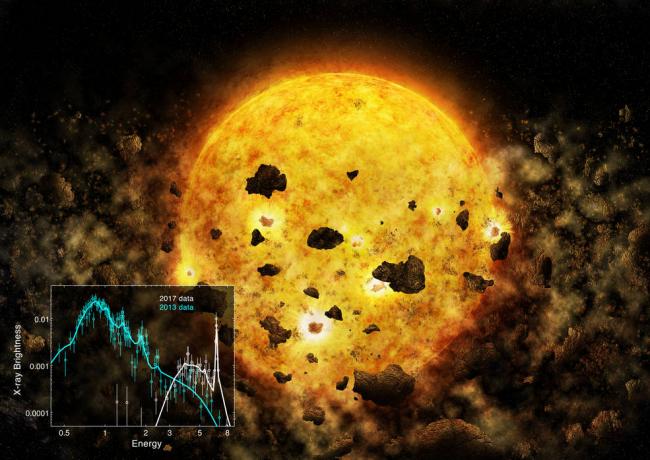
Washington, July 19 (IBNS): Scientists may have observed, for the first time, the destruction of a young planet or planets around a nearby star.
Observations from NASA’s Chandra X-ray Observatory indicate that the parent star is now in the process of devouring the planetary debris.
This discovery gives insight into the processes affecting the survival of infant planets.
Since 1937, astronomers have puzzled over the curious variability of a young star named RW Aur A, located about 450 light years from Earth. Every few decades, the star’s optical light has faded briefly before brightening again. In recent years, astronomers have observed the star dimming more frequently, and for longer periods, read the NASA website.
Using Chandra, a team of scientists may have uncovered what caused the star's most recent dimming event: a collision of two infant planetary bodies, including at least one object large enough to be a planet. As the resulting planetary debris fell into the star, it would generate a thick veil of dust and gas, temporarily obscuring the star’s light.
“Computer simulations have long predicted that planets can fall into a young star, but we have never before observed that,” says Hans Moritz Guenther, a research scientist in MIT’s Kavli Institute for Astrophysics and Space Research who led the study. “If our interpretation of the data is correct, this would be the first time that we directly observe a young star devouring a planet or planets.”
The star’s previous dimming events may have been caused by similar smash-ups, of either two planetary bodies or large remnants of past collisions that met head-on and broke apart again.
RW Aur A is located in the Taurus-Auriga Dark Clouds, which host stellar nurseries containing thousands of infant stars. Very young stars, unlike our relatively mature sun, are still surrounded by a rotating disk of gas and clumps of material ranging in size from small dust grains to pebbles, and possibly fledgling planets. These disks last for about 5 million to 10 million years.
RW Aur A is estimated to be several million years old, and is still surrounded by a disk of dust and gas. This star and its binary companion star, RW Aur B, are both about the same mass as the sun.
The noticeable dips in the optical brightness of RW Aur A that occurred every few decades each lasted for about a month. Then, in 2011, the behavior changed. The star dimmed again, this time for about six months. The star eventually brightened, only to fade again in mid-2014. In November 2016, the star returned to its full brightness, and then in January 2017 it dimmed again.
Chandra was used to observe the star during an optically bright period in 2013, and then dim periods in 2015 and 2017, when a decrease in X-rays was also observed.
Because the X-rays come from the hot outer atmosphere of the star, changes in the X-ray spectrum – the intensity of X-rays measured at different wavelengths – over these three observations were used to probe the density and composition of the absorbing material around the star.
The team found that the dips in both optical and X-ray light are caused by dense gas obscuring the star’s light. The observation in 2017 showed strong emission from iron atoms, indicating that the disk contained at least 10 times more iron than in the 2013 observation during a bright period.
Guenther and colleagues suggest the excess iron was created when two planetesimals, or infant planetary bodies, collided. If one or both planetary bodies are made partly of iron, their smash-up could release a large amount of iron into the star’s disk and temporarily obscure its light as the material falls into the star.
A less favored explanation is that small grains or particles such as iron can become trapped in parts of a disk. If the disk’s structure changes suddenly, such as when the star’s partner star passes close by, the resulting tidal forces might release the trapped particles, creating an excess of iron that can fall into the star.
The scientists hope to make more observations of the star in the future, to see whether the amount of iron surrounding it has changed – a measure that could help researchers determine the size of the iron’s source. For example, if about the same amount of iron appears in a year or two that may indicate it comes from a relatively massive source.
“Much effort currently goes into learning about exoplanets and how they form, so it is obviously very important to see how young planets could be destroyed in interactions with their host stars and other young planets, and what factors determine if they survive,” Guenther says.
Guenther is the lead author of a paper detailing the group’s results, which appears today in the Astronomical Journal. NASA's Marshall Space Flight Center in Huntsville, Alabama, manages the Chandra program for NASA's Science Mission Directorate in Washington. The Smithsonian Astrophysical Observatory in Cambridge, Massachusetts, controls Chandra's science and flight operations.
Support Our Journalism
We cannot do without you.. your contribution supports unbiased journalism
IBNS is not driven by any ism- not wokeism, not racism, not skewed secularism, not hyper right-wing or left liberal ideals, nor by any hardline religious beliefs or hyper nationalism. We want to serve you good old objective news, as they are. We do not judge or preach. We let people decide for themselves. We only try to present factual and well-sourced news.







